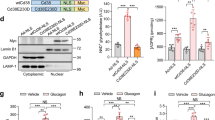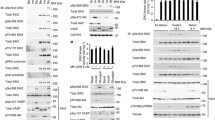Abstract
Transcription of the L-type pyruvate kinase (L-PK) and S14 genes is induced in hepatocytes in response to increased glucose metabolism. The regulatory sequences of these genes responsible for induction by glucose have been mapped to related E-box containing motifs in the promoters. Similarly, L-PK promoter activity is stimulated in a differentiated pancreatic β-cell line, INS-1, in response to elevated glucose. By mutational analysis, we demonstrate that the sequence requirements for glucose induction in the INS-1 cell are identical to those observed in the hepatocyte, suggesting that the same transcriptional factor(s) is responsible for regulation of L-PK expression in the two cell types. One nuclear factor that binds to the glucose regulatory sequences of both of these genes is the Upstream Stimulatory Factor (USF), a ubiquitous E-box binding protein. Mice deleted for the USF2 gene display a severely delayed response to carbohydrate feeding (Valletet al. [26]). This observation, however, does not differentiate between a direct and an indirect role for USF in the process. To gain further insight into the possible involvement of USF in glucose signaling, we have used a recombinant adenoviral construct that expresses a dominant negative form of USF. This dominant negative can dimerize with endogenous USF and is shown to inhibit DNA binding of USF in hepatocytes and INS-1 cells. However, expression of the dominant negative USF did not block the ability of glucose to stimulate L-PK or S14 gene expression in hepatocytes or L-PK promoter activity in INS-1 cells. We conclude that USF does not act by binding to the glucose regulatory sequences of the S14 or L-PK genes and the role of USF in the process of glucose induction is indirect.
Similar content being viewed by others
References
Hillgartner FB, Salati LM, Goodridge AG: Physiological and molecular mechanisms involved in nutritional regulation of fatty acid synthesis. Phys Rev 75: 47–76, 1995
Towle HC, Kaytor EN, Shih H-M: Regulation of the expression of lipogenic enzyme genes by carbohydrate. Annu Rev Nutr 17: 405–433, 1997
Girard J, Ferre P, Foufelle F: Mechanisms by which carbohydrates regulate expression of genes for glycolytic and lipogenic enzymes. Annu Rev Nutr 17: 325–352, 1997
Vaulont S, Kahn A: Transcriptional control of metabolic regulation genes by carbohydrates. FASEB J 8: 28–35, 1994
Jump DB, Oppenheimer JH: High basal expression and 3,5,3′-triiodothyronine regulation of messenger ribonucleic acid S14 in lipogenic tissues. Endocrinology 117: 2259–2266, 1985
Kinlaw WB, Church JL, Harmon J, Mariash CN: Direct evidence for a role of the "spot 14' protein in the regulation of lipid synthesis. J Biol Chem 270: 16615–16618, 1995
Vaulont S, Munich A, Decaux JF, Kahn A: Transcriptional and post-transcriptional regulation of L-type pyruvate kinase gene expression in rat liver. J Biol Chem 261: 7621–7625, 1986
Jump DB, Bell A, Santiago V: Thyroid hormone and dietary carbohydrate interact to regulate rat liver S14 gene transcription and chromatin structure. J Biol Chem 265: 3474–3478, 1990
Bergot M-O, Diaz-Guerra M-JM, Puzenat N, Raymondjean M, Kahn A: Cis-regulation of the L-type pyruvate kinase gene promoter by glucose, insulin and cyclic AMP. Nucl Acids Res 20: 1871–1878, 1992
Liu Z, Thompson KS, Towle HC: Carbohydrate regulation of the rat L-type pyruvate kinase gene requires two nuclear factors: LFA1 and a member of the c-myc family. J Biol Chem 268: 12787–12795, 1993
Shih H-M, Towle HC: Definition of the carbohydrate response element of the rat S14 gene: Context of the CACGTG motif determines the specificity of carbohydrate regulation. J Biol Chem 269: 9380–9387, 1994
Shih H-M, Liu Z, Towle HC: Two CACGTG motifs with proper spacing dictate the carbohydrate regulation of hepatic gene transcription. J Biol Chem 270: 21991–21997, 1995
Docherty K, Clark AR: Nutrient regulation of insulin gene expression. FASEB J 8: 20–27, 1994
Melloul D, Ben-Neriah Y, Cerasi E: Glucose modulates the binding of an islet-specific factor to a conserved sequence within the rat I and the human promoters. Proc Natl Acad Sci USA 90: 3865–3869, 1993
German MS, Wang J: The insulin gene contains multiple transcriptional elements that respond to glucose. Mol Cell Biol 14: 4067–4075, 1994
Sharma A, Fusco-DeMane D, Henderson E, Efrat S, Stein R: The role of the insulin control element and RIPE3b1 activators in glucose-stimulated transcription of the insulin gene. Mol Endocrinol 9: 1468–1476, 1995
MacFarlane WM, Read ML, Gilligan M, Bujalska I, Docherty K: Glucose modulates the binding activity of the β-cell transcription factor IUF1 in a phosphorylation-dependent manner. Biochem J 303: 625–631, 1994
Marie S, Diaz-Guerra M-J, Miquerol L, Kahn A, Iynedjian PB: The pyruvate kinase gene as a model for studies of glucosedependent regulation of gene expression in the endocrine pancreatic beta-cell type. J Biol Chem 268: 23881–23890, 1993
Olson LK, Qian J, Poitout V: Glucose rapidly and reversibly decreases INS-1 cell insulin gene transcription via decrements in STF-1 and C1 activator transcription factor activity. Mol Endocrinol 12: 207–219, 1998
Atchley WR, Fitch WM: A natural classification of the basic helix-loop-helix class of transcription factors. Proc Natl Acad Sci USA 94: 5172–5176, 1997
Kadesch T: Consequences of heteromeric interactions among helix-loop-helix proteins. Cell Growth Differ 4: 49–55, 1993
Sirito M, Walker S, Lin Q, Kozlowski MT, Klein WH, Sawadogo M: Members of the USF family of helix-loop-helix proteins bind DNA as homo-as well as heterodimers. Gene Expr 2: 231–240, 1992
Viollet B, Lefrancois-Martinez A-M, Henrion A, Kahn A, Raymondjean M, Martinez A: Immunochemical characterization and transacting properties of upstream stimulatory factor isoforms. J Biol Chem 271: 1405–1415, 1996
Vaulont S, Puzenat N, Levrat F, Cognet M, Kahn A, Raymondjean M: Proteins binding to the liver-specific pyruvate kinase gene promoter: A unique combination of known factors. J Mol Biol 209: 205–219, 1989
Diaz Guerra M-JM, Bergot M-O, Martinez A, Cuif M-H, Kahn A, Raymondjean M: Functional characterization of the L-type pyruvate kinase gene glucose response complex. Mol Cell Biol 13: 7725–7733, 1993
Vallet VS, Henrion AA, Bucchini D, Casado M, Raymondjean M, Kahn A, Vaulont S: Glucose-dependent liver gene expression in upstream stimulatory factor 2-/-mice. J Biol Chem 272: 21944–21949, 1997
Kennedy HJ, Viollet B, Rafiq I, Kahn A, Rutter GA: Upstream stimulatory factor-2 (USF2) activity is required for glucose stimulation of L-pyruvate kinase promoter activity in single living islet β-cells. J Biol Chem 272: 20636–20640, 1997
Sirito M, Lin Q, Maity T, Sawadogo M: Ubiquitous expression of the 43-and 44kDa forms of transcription factor USF in mammalian cells. Nuc Acids Res 22: 427–433, 1994
Potter JJ, Cheneval D, Dang CV, Resar LMS, Mezey E, Yang VW: The upstream stimulatory factor binds to and activates the promoter of the rat class I alcohol dehydrogenase gene. J Biol Chem 266: 15457–15463, 1991
Viollet B, Kahn A, Raymondjean M: Protein kinase A-dependent phosphorylation modulates DNA-binding activity of Hepatocyte Nuclear Factor 4. Mol Cell Biol 17: 4208–4219, 1997
Kaytor EN, Shih H-M, Towle HC: Carbohydrate regulation of hepatic gene expression. Evidence against a role for the upstream stimulatory factor. J Biol Chem 272: 7525–7531, 1997
Lefrancois-Martinez A-M, Martinez A, Antoine B, Raymondjean M, Kahn A: Upstream stimulatory factor proteins are major components of the glucose response complex of the L-type pyruvate kinase gene promoter. J Biol Chem 270: 2640–2643, 1995
Shih H-M, Towle HC: Definition of the carbohydrate response element of the rat S14 gene: Evidence for a common factor required for carbohydrate regulation of hepatic genes. J Biol Chem 267: 13222–13228, 1992
Qian J, Kaytor EN, Towle HC, Olson LK: Upstream stimulatory factor regulates Pdx-1 gene expression in differentiated pancreatic β-cells. Biochem J 341: 315–322, 1999
Meier JL, Lui X, Sawadogo M, Straus SE: The cellular transcription factor USF cooperates with varicella-zoster virus immediate-early protein 62 to symmetrically activate a bidirectional viral promoter. Mol Cell Biol 14: 6896–6906, 1994
Becker TC, Noel RJ, Coats WS, Gomez-Foix AM, Alam T, Gerard RD, Newgard CB: Use of recombinant adenovirus for metabolic engineering of mammalian cells. Methods Cell Biol 43: 161–189, 1994
Schreiber E, Matthias P, Muller MM, Schaffner W: Rapid detection of octamer binding proteins with ‘mini extracts’ prepared from a small number of cells. Nuc Acids Res 17: 6419, 1989
Celi FS, Zenilman ME, Shuldiner AR: A rapid and versatile method to synthesize internal standards for competitive PCR. Nucl Acids Res 21: 1047, 1993
Asfari M, Janjic D, Meda P, Li G, Halban PA, Wollheim CB: Establishment of 2-mercaptoethanol-dependent differentiated insulin-secreting cell lines. Endocrinology 130: 167–178, 1992
Vallet VS, Casado M, Henrion AA, Bucchini D, Raymondjean M, Kahn A, Vaulont S: Defferential roles of upstream stimulatory factors 1 and 2 in the transcriptional response of liver genes to glucose. J Biol Chem 273: 20175–20179, 1998
Timchenko N, Wilson DR, Taylor LR, Abdelsayed S, Wilde M, Sawadogo M, Darlington GJ: Autoregulation of the human C/ EBP alpha gene by stimulation of upstream stimulatory factor binding. Mol Cell Biol 15: 1192–1202, 1995
Brown MS, Goldstein JL: The SREBP pathway: Regulation of cholesterol metabolism by proteolysis of a membrane-bound transcription factor. Cell 89: 331–340, 1997
Kim JB, Spotts GD, Halvorsen Y-D, Shih H-M, Ellenberger T, Towle HC, Spiegelman BM: Dual DNA binding specificity of ADD1/SREBP1 controlled by a single amino acid in the basic helix-loop-helix domain. Mol Cell Biol 15: 2582–2588, 1995
Lopez JM, Bennett MK, Sanchez HB, Rosenfeld JM, Osborne TF: Sterol regulation of acetyl coenzyme A carboxylase: A mechanism for coordinate control of cellular lipid. Proc Natl Acad Sci USA 93: 1049–1053, 1996
Magana MM, Osborne TF: Two tandem binding sites for sterol regulatory element binding proteins are required for sterol regulation of fatty-acid synthase promoter. J Biol Chem 271: 32689–32694, 1996
Ericsson J, Jackson SM, Kim JB, Spiegelman BM, Edwards PA: Idenfication of glycerol-3-phosphate acyltransferase as an adipocyte determination and differentiation factor 1-and sterol regulatory element-binding protein-responsive gene. J Biol Chem 272: 7298–7305, 1997
Tabor DE, Kim JB, Spiegelman BM, Edwards PA: Transcriptional activation of the stearoyl-CoA desaturase 2 gene by sterol regulatory element-binding protein/adipocyte determination and differentiation factor 1. J Biol Chem 273: 22052–22058, 1998
Kim JB, Sarraf P, Wright M, Yao KM, Mueller E, Solanes G, Lowell BB, Spiegelman BM: Nutritional and insulin regulation of fatty acid synthetase and leptin gene expression through ADD1/ SREBP1. J Clin Invest 101: 1–9, 1998
Shimano H, Horton JD, Hammer RE, Shimomura I, Brown MS, Goldstein JL: Overproduction of cholesterol and fatty acids causes massive liver enlargement in transgenic mice expressing truncated SREBP-1a. J Clin Invest 98: 1575–1584, 1996
Shimomura I, Shimano H, Korn BS, Bashmakov Y, Horton JD: Nuclear sterol regulatory element-binding proteins activate genes responsible for the entire program of unsaturated fatty acid biosynthesis in transgenic mouse liver. J Biol Chem 273: 35299–35306, 1998
Foretz M, Pacot C, Dugail I, Lemarchand P, Guichard C, Liepvre XL, Berthelier-Lubrano C, Spiegelman B, Kim JB, Ferre P, Foufelle F: ADD1/SREBP-1c is required in the activation of hepatic lipogenic gene expression by glucose. Mol Cell Biol 19: 3760–3768, 1999
Moriizumi S, Gourdon L, Lefrancois-Martinez A-M, Kahn A, Raymondjean M: Effect of different basic helix-loop-helix leucine zipper factors on the glucose respone unit of the L-type pyruvate kinase gene. Gene Expression 7: 103–113, 1998
Kim K-H: Regulation of acetyl-CoA carboxylase. Curr Top Cell Regul 22: 143–176, 1983
Yamada K, Tanaka T, Noguchi T: Characterization and purification of carbohydrate response element-binding protein of the rat L-type pyruvate kinase gene promoter. Biochem Biophys Res Commun 257: 44–49, 1999
Hasegawa J-I, Osatomi K, Wu R-F, Uyeda K: A novel factor binding to the glucose response elements of liver pyruvate kinase and fatty acid synthase genes. J Biol Chem 274: 1100–1107, 1999
Author information
Authors and Affiliations
Rights and permissions
About this article
Cite this article
Kaytor, E., Qian, J., Towle, H. et al. An indirect role for upstream stimulatory factor in glucose-mediated induction of pyruvate kinase and S14 gene expression. Mol Cell Biochem 210, 13–21 (2000). https://doi.org/10.1023/A:1007006429041
Issue Date:
DOI: https://doi.org/10.1023/A:1007006429041




